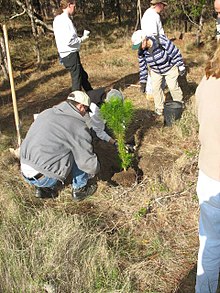Urban reforestation

Urban reforestationis the practice ofplanting trees,typically on a large scale, inurban environments.[1]It may also includeurban horticultureandurban farming.[2]
Benefits
[edit]Reasons for practicing urban reforestation include urbanbeautification;increasing shade;[1]modifying theurban climate;[3]improvingair quality,[4]such as by sequestering carbon dioxide;[5]and restoration ofurban forestsafter anatural disaster.[6]Increased shade from urban reforestation can also lead to decreased energy costs, as heat from the sun is blocked from heating structures that useair conditioning.[5]These benefits may aid in increasing localproperty values,filteringrainwaterpollutantsfrom the streets and thus improvingwater quality,[7]and creating morehabitatsforwildlife,[7]particularly endangered species.[5]
Urban reforestation may also be effective because it does not require the purchase of a large piece of land to execute.[8]
Programs
[edit]Australia
[edit]TheUrban Reforestationorganization in Australia is a grassroots organization that focuses onsustainable livingin urban places.[2]
United States
[edit]Large scale urban reforestation programs in theUnited StatesincludeNew York City'sMillion Tree Initiative[9]andTreePeopleinLos Angeles,which planted 1 million trees in preparation for the1984 Summer Olympicsand continued planting thereafter.[1]In 2022,Bostonannounced a new forestry division to grow the tree canopy within the city.[10]
Grassroots efforts includeFriends of the Urban ForestinSan Francisco,which advocates for the planting of street trees.[1]
In California, there are government funded programs such as theCalifornia Department of Forestry and Fire Protection's Urban ForestryProgram. They advocate for localsustainabilityas well as health and happiness for the community long term.[11]This Urban Forestry Program also seeks to aiddisadvantagedand/orlow-incomecommunities.[12]
Climate change
[edit]Most cities have the potential to use urban reforestation as a means of combatingclimate change.[13]Urban reforestation can also contribute to lowering energy consumption.[13]
Concerns
[edit]
Urban reforestation efforts compete for money and urban land that could be used for other purposes. For example, effort placed in planting new trees can take away from maintenance of already established trees.[9]Equity of where urban reforestation occurs may also be questioned. Programs such as California Department of Forestry and Fire Protection's Urban Forestry target these communities, but this is not always the case.Inequalityin distribution of trees planted during Urban Reforestation leads to inequality of life. Permanence of trees is also an issue as a tree planted is a tree that might have to be removed in the future due to preferences ofland ownersin urban spaces.[5]
Urban reforestation projects may also lack support in neighborhoods where environmentalist groups do not sufficiently involve residents in planning and decision-making, particularly when white environmentalists are conducting projects in communities of color, as noted in a 2014 report byenvironmental sociologistDorceta Taylorfrom theUniversity of Michigan.For example, from 2011 to 2014, anonprofit organizationnamedThe Greening of Detroitplanted thousands of new trees to restoreDetroit's tree canopy. However, about a quarter of residents offered free trees in front of their homes submitted a "no tree request". Although they recognized the benefits of urban forestry, they didn't trust the organization staff, who were predominantly white and not from Detroit. They also felt that they didn't have enough say in what was being planted since they expected to be given responsibility for maintaining the trees planted in their neighborhoods, as previous reforestation project trees received inadequate care from the city and caused issues with appearance and safety.[14]Residents were a lot more open to the idea of receiving free trees if they got to choose what was planted.[15]
See also
[edit]- Tree planting
- Forest restoration
- Rewilding
- Urban agriculture
- Urban forest inequity
- Urban green space
- Urban prairie
- Urban resilience
References
[edit]- ^abcdGary Moll, Sara Ebenreck (1989).Shading Our Cities: A Resource Guide For Urban And Community Forests.Island Press.ISBN978-0-933280-95-3.
- ^abJackson, Andra (11 June 2010)."Green thumbs and high-rise ambitions".The Age.Nine Entertainment Co. Pty Limited.Retrieved25 January2023.
- ^Hall, Justine M.; John F. Handley; A. Roland Ennos (15 March 2012). "The potential of tree planting to climate-proof high density residential areas in Manchester, UK".Landscape and Urban Planning.104(3–4): 410–417.Bibcode:2012LUrbP.104..410H.doi:10.1016/j.landurbplan.2011.11.015.
- ^Taha, Halder (May 2008). "Urban Surface Modification as a Potential Ozone Air-quality Improvement Strategy in California: A Mesoscale Modelling Study".Boundary-Layer Meteorology.127(2): 219–239.Bibcode:2008BoLMe.127..219T.doi:10.1007/s10546-007-9259-5.S2CID119573663.
- ^abcdPerkins, Harold A; Heynen, Nik; Wilson, Joe (1 August 2004)."Inequitable access to urban reforestation: the impact of urban political economy on housing tenure and urban forests".Cities.21(4): 291–299.doi:10.1016/j.cities.2004.04.002.ISSN0264-2751.
- ^Lisa L. Burban, John W. Anderson (1996).Storms Over the Urban Forest: Planning, Responding, and Regreening - A Community Guide to Natural Disaster Relief.DIANE Publishing.ISBN978-0-7881-2948-3.
- ^ab"Urban & Community Forestry".www.fire.ca.gov.Retrieved20 October2022.
- ^Kroeger, Timm; Escobedo, Francisco J.; Hernandez, José L.; Varela, Sebastián; Delphin, Sonia; Fisher, Jonathan R. B.; Waldron, Janice (7 October 2014)."Reforestation as a novel abatement and compliance measure for ground-level ozone".Proceedings of the National Academy of Sciences.111(40): E4204-13.Bibcode:2014PNAS..111E4204K.doi:10.1073/pnas.1409785111.ISSN0027-8424.PMC4210021.PMID25201970.
- ^abCorso, Phil."Avella opposes mayor's Million Trees effort".TimesLedger. Archived fromthe originalon 23 January 2013.Retrieved31 January2013.
- ^Abel, David; Anderson, Travis (21 September 2022)."Wu announces forestry division to preserve and expand tree canopy in Boston - The Boston Globe".Boston Globe.Retrieved10 October2022.
- ^"Urban & Community Forestry".www.fire.ca.gov.Retrieved10 October2022.
- ^"Urban and Community Forestry Grant Programs".www.fire.ca.gov.Retrieved10 October2022.
- ^abTeo, Hoong Chen; Zeng, Yiwen; Sarira, Tasya Vadya; Fung, Tze Kwan; Zheng, Qiming; Song, Xiao Ping; Chong, Kwek Yan; Koh, Lian Pin (2021)."Global urban reforestation can be an important natural climate solution".Environmental Research Letters.16(3): 034059.Bibcode:2021ERL....16c4059T.doi:10.1088/1748-9326/abe783.S2CID233888804.
- ^Mock, Brentin (11 January 2019)."Why Detroit Residents Pushed Back Against Tree-Planting".Bloomberg.Bloomberg L.P.Retrieved25 January2023.
- ^Goldman, Jason G. (22 January 2019)."Do-Gooders Should Survey Communities First".Scientific American.Retrieved25 January2023.
